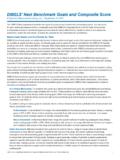Transcription of GETTING STARTED WITH DIBELS
1 Sutkizesjaldoslavmukvosijhepjovkuljitles lajimrovvaknelhusipvuffeshandovtofyajlec sijyucfifuzwabtozbepsocnezvugfakicrucnav jojkepjidjilaprezfumdolRevised 12/30/10 Benchmark AssessmentKindergarten Scoring BookletName: _____Student ID: _____School Year: _____Teacher: _____School: _____GRADEKB eginningMiddleEndDateFSFLNFPSFNWFCLSCLSW WRWWR123 What is DIBELS ? DIBELS is a set of measures and procedures for assessing the acquisition of early literacy skills from kindergarten through sixth grade. DIBELS stands for Dynamic Indicators of Basic Early Literacy Skills, and is comprised of six measures that function as indicators of the essential skills that every child must master to become a proficient reader.
2 The DIBELS measures are brief (most take one minute to administer), and are used to regularly monitor the development of early literacy and early reading skills. DIBELS was designed for use in identifying children experiencing difficulty in the acquisition of basic early literacy skills, in order to provide support early and prevent the occurrence of later reading assessments are: brief efficient cost-effective individually administered standardized formativeName of DIBELS MeasureBasic Early Literacy Skill MeasuredGrades Used for Benchmark Assessment/ScreeningFirst Sound Fluency (FSF)Phonemic AwarenessKindergartenLetter Naming Fluency (LNF)Indicator of risk.
3 Not a measure of an essential, basic early literacy skillKindergarten, Early First GradePhoneme Segmentation Fluency (PSF)Phonemic AwarenessKindergarten, Early First GradeNonsense Word Fluency (NWF)Alphabetic Principle and Basic PhonicsKindergarten, First Grade, Early Second GradeDIBELS Oral Reading Fluency (DORF)Advanced Phonics and Word Attack Skills, Accuracy and Fluency with Connected Text, Reading ComprehensionFirst Sixth GradesDazeReading ComprehensionThird Sixth GradesGETTING STARTED with DIBELS Why Use DIBELS ?
4 The purposes of DIBELS are: to identify students who may be at risk for reading difficulties (universal screening); to help teachers identify areas to target instructional support; to monitor at-risk students while they receive additional, targeted instruction; and to examine the effectiveness of your school s system of instructional advantages of DIBELS are: DIBELS has been specifically designed to be used within a problem-solving, outcomes-driven model of decision-making and response to intervention.
5 The DIBELS measures are reliable and valid. Research-based benchmark goals are available which define a level at which the odds are in the student s favor of meeting later reading outcome goals. Spanish (IDEL ) and French (IDAPEL) versions are also STARTED with DIBELST here are five topics to consider when GETTING STARTED with DIBELS : DIBELS materials Training Data management and reporting Using DIBELS to make educational decisions LogisticsDIBELS MaterialsThe current version of DIBELS is DIBELS Next.
6 DIBELS Next can be obtained in three ways:1. Published: Next can be purchased from our publisher, Voyager/Sopris Learning. The published version is in color and includes a user-friendly flip-book format, with the student materials on one side and the assessor directions on the other side. Components can be ordered in classroom sets (a good choice for the first year) or individually (when additional components are needed, or to replace consumable components such as scoring booklets). An order form is available on the Sopris website with pricing Mobile-to-Web: s mCLASS : DIBELS Next mobile assessment solution is available for a variety of handheld devices.
7 The mCLASS system includes the Sopris-published student materials in color. mCLASS automates scoring, data analysis, and reporting. For more information and pricing, contact Download: Next is available for free download from our website. The Assessment Manual and all testing materials can be downloaded. The download version is in black and white. Instructions are available for printing and photocopying. Pricing for this version will be based on your school s printing and photocopying costs. Page 112 DIBELS Oral Reading FluencyGrade 1/Benchmark words: _____Errors (include skipped words): _____Words correct: = _____A Busy Bee0142741546975891021161291411561731811 93208223 The sun is rising, telling the bees it s time to get busy.
8 The worker bees leave the hive. They are looking for nectar, a sweet liquid, and pollen, a yellow dust. The bees use these things to make food and honey. One bee finds a garden and climbs inside a flower. It drinks the nectar. The nectar is stored in a sack in the bee s body. As it walks around, pollen sticks to its legs. When the nectar sack is full, the bee flies back to the hive. The other workers greet the bee. To tell where the nectar and pollen came from, the worker does a dance. The way the bee moves tells where the garden is.
9 The other bees rush off to get more nectar and pollen. The worker bee climbs over many other bees. Most of them are worker bees, too. One bee is bigger than any other. It is the queen. Her job is to lay eggs. A third kind of bee, the drone, does not have a stinger. Its job is to mate with the queen. The worker gives the nectar and pollen to another worker bee. This bee has the job of making food. Once the bee has delivered its load, it flies out again. In all, this worker bee will make about ten trips each day.
10 It might fly as far as six miles away. Now that s a busy bee!142741546975891021161291411561731811 93208223237 Page 10 3 DIBELS Phoneme Segmentation FluencyGrade K/Benchmark 3 ScoreTotal: _____PSF Response Patterns:Repeats wordMakes random errorsSays initial sound onlySays onset rimeDoes not segment blendsAdds soundsOther Probe 1 DIBELS Next Edition Draft Phoneme Segmentation Fluency 2010 Dynamic Measurement Group, /a/ /k/hole/h/ /oa/ /l/trip/t/ /r/ /i/ /p/game/g/ /ai/ /m//13fox/f/ /o/ /k/ /s/toes/t/ /oa/ /z/star/s/ /t/ /ar/sheep/sh/ /ea/ /p//13pine/p/ /ie/ /n/forth/f/ /or/ /th/fought/f/ /o/ /t/which/w/ /i/ /ch//12cold/k/ /oa/ /l/ /d/shout/sh/ /ow/ /t/bit/b/ /i/ /t/send/s/ /e/ /n/ /d//14/w/ /uu/ /d/dreamed/d/ /r/ /ea/ /m/ /d/red/r/ /e/ /d/sell/s/ /e/ /l//14kicked/k/ /i/ /k/ /t/chin/ch/ /i/ /n/him/h/ /i/ /m//13 Probe 2 DIBELS Next Edition Draft Phoneme Segmentation FluencyPage 2 2010 Dynamic Measurement
